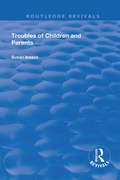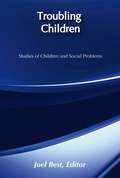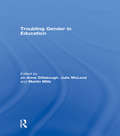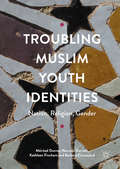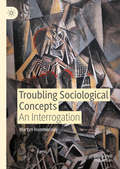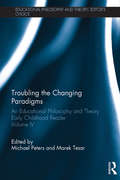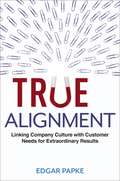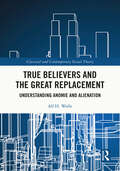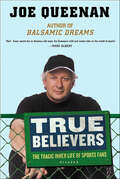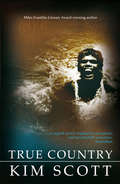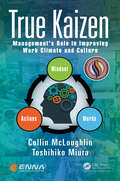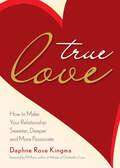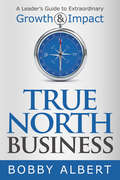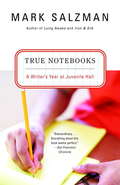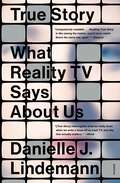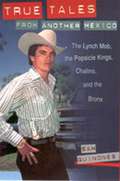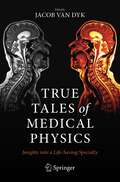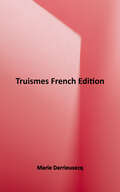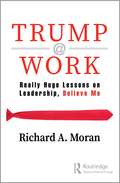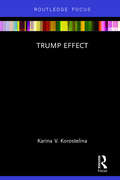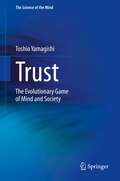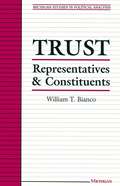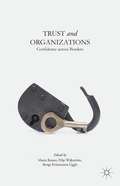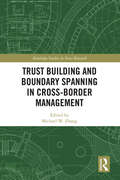- Table View
- List View
Troubles of Children and Parents (Routledge Revivals)
by Susan IsaacsPublished in 1948: Parents have many problems. Those dealt with in this are mainly the social and emotional difficulties arising in the development of children in their early years. The material is selected from a much larger bulk of actual letters from parents and nurses which the author answered under the pseudonym of "Ursula Wise" in The Nursery World (published by Benn Bros.) during the years 1929-36.
Troubling Children: Studies of Children and Social Problems (Social Problems And Social Issues Ser.)
by Joel BestIncreasingly, sociologists have turned their attention to the social problems of children– in particular, of younger children. This collection reflects those recent interest. While most researchers have focused on social problems involving adolescents, this volume offers instead original case studies of problems concerning preadolescent children.The papers that Best has gathered here represent different theoretical and methodological approaches. They report on social issues in Albania, Kenya, and Japan as well as in the United States. The range of social problems they address is a wide one, from broad societal crises to decision-making within families. Topics include the effects of economic and social crises in Africa and Eastern Europe; concerns about crack use and other forms of fetal endangerment; parental decisions about spanking, toy choices, and letting children listen to rock music; schooling in day care and elementary and junior high schools; and children's perceptions of environmental crises.Troubling Children adds a new dimension to courses in social problems. It also offers a different set of perspectives for those concerned with sociology of preadolescent children and their discontents.
Troubling Gender in Education
by Martin Mills Julie McLeod Jo-Anne DillaboughThis book explores new questions and lines of analysis within the field of ‘gender and education’, conveying some of the style and diversity of contemporary research directions. It celebrates as well as assesses the achievements of feminist work in education, acknowledging this legacy while also ‘troubling’ and opening up for critical reflection any potential stalemates and sticking points in research trends on gender and education. The collection has a strong cross-cultural focus, with chapters exploring experiences of students and teachers in the UK, the US, Australia, Canada, Hawaii and South Africa. The chapters examine topics relevant to both boys’ and girls’ education and to forms of education which span different sectors and both informal and formal spaces. Issues examined include citizenship and belonging, affect, authority and pedagogy, sexuality and the body, racism, and national identity and new and emerging forms of masculinity and femininity. Across these varied terrains, each of the authors engages with theoretical work informed by a broad range of disciplinary and interdisciplinary approaches from across the social sciences and humanities, drawing variously from postcolonial, queer, and new sociological theories of modernity and identity, as well as from fields such as cultural geography and narrative studies. This collection of thought-provoking essays is essential reading for scholars and graduate students wanting to understand the current state of play on research and theory on ‘gender and education’.This book was published in a special issue of Discourse: Studies in the Cultural Politics of Education.
Troubling Muslim Youth Identities: Nation, Religion, Gender
by Máiréad Dunne Naureen Durrani Kathleen Fincham Barbara CrossouardThis book explores the production of Muslim youth identities, with respect to nation, religion and gender in Pakistan, Senegal, Nigeria and Lebanon. As Muslim-majority, post-colonial states with significant youth populations, these countries offer critical case studies for the exploration of the different grammars of youth identities, and ‘trouble’ the perceived homogeneity of Muslims in local and global imaginaries. The authors offer rigorous and detailed accounts of the local, situated and contingent ways in which youth articulate their identities and sense of belonging, and the book reflects on the importance of affect, belonging and affiliation in the construction of youth narratives of identity as well as highlighting their political and contested nature. Troubling Muslim Youth Identities will be of interest to students and scholars in the fields of development studies, social and cultural studies, gender, geography, education, and peace and conflict studies.
Troubling Sociological Concepts: An Interrogation
by Martyn HammersleySociology addresses challenging social issues and seeks new ways to understand them. However, much sociological terminology suffers from multiple, vague, or uncertain meanings. This is true of many of the central terms that sociologists use, such as ‘power’, ‘ideology’, ‘culture’, ‘social class’, and even ‘society’. The result is that the conclusions reached by sociological investigations are frequently subject to discrepant interpretations, and their validity is difficult to assess. The chapters in this book address several of the key terms employed by sociologists, examining the concepts associated with them in depth – from both an historical and an analytical perspective. The aim is not to develop an entirely new framework but rather to document the various meanings associated with these terms, and to suggest ways in which they could be refined or developed for the purposes of sociological analysis. Since the concepts addressed are of wide relevance, Troubling Sociological Concepts will be of interest and use to researchers and students across the social sciences.
Troubling the Changing Paradigms: An Educational Philosophy and Theory Early Childhood Reader, Volume IV (Educational Philosophy and Theory: Editor’s Choice)
by Michael A. Peters Marek TesarTroubling the Changing Paradigms is the fourth volume in the Educational Philosophy and Theory: Editor’s Choice series and represents a collection of texts that were selected as representations of the philosophy and pedagogy of early years, childhood and early childhood education. The philosophy of the early years is complex, and this book demonstrates how this fascinating subject can be interlinked with both the philosophy and history of education as being instrumental in shaping the child subject, childhoods and children’s educational futures. This book demonstrates the application of philosophical and theoretical perspectives that provide us with global and local narratives and understandings of children as subjects, and their subjectivities. The philosophical traditions offer new spaces in which to think about alternative childhoods, and contribute to an important analysis in which philosophy has the capacity to shape children’s lives and education, and to elevate the multiplicity of discourses around very young children and their education and care. Through the texts in this volume, the authors aim to find creative philosophical forms that are capable of interrupting, if not disrupting, traditional and, in some settings, perhaps more conventional discourses about children and their childhoods. These philosophical forms present productive ways that allow fresh conceptions of what is all too often an assumed set of subjectivities and experiences about very young children. Troubling the Changing Paradigms will be key reading for academics, researchers and postgraduate students in the fields of philosophy of education, philosophy, education, educational theory, post-structural theory, the policy and politics of education, and the pedagogy of education.
True Alignment: Linking Company Culture with Customer Needs for Extraordinary Results
by Edgar PapkeAlignment is the single most critical business challenge for any organization and its leaders. Without it, inefficiency, conflict, and disengagement will cripple your ability to provide value to your customers. Companies live or die based on their ability to communicate and deliver on the promise their brand makes to its customers. To do this effectively, leaders need to clearly define the vision and strategies that support that brand intention and ensure these are manifested in the roles, expectations, and goals of each and every member of the organization. A blueprint for businesses of all types and sizes, True Alignment reveals how to: * Decipher customer expectations * Define the brand as a solution to the customer's needs * Turn the unique selling proposition into the mission * Create a company culture where everyone is aligned to this vision--and responsible for living the brand promise * And more Whether you're a manager, a business owner, an executive, or CEO, True Alignment is an essential resource that will help you compete and succeed in today's complex and rapidly changing business environment.
True Believers and the Great Replacement: Understanding Anomie and Alienation (Classical and Contemporary Social Theory)
by Alf H. WalleTrue Believers and the Great Replacement explores the responses of segments of Western cultures who fear that changes in the racial, religious, and ethnic makeup of society threaten their way of life. The Great Replacement Theory (that suggests that the traditional character of Western society is being undermined by outsiders) is discussed. Analysed with reference to the Critical Race Theory and the ‘Cancel Culture’ movement, the author examines the anxieties and reactions of those who feel alienated by a world of rapid and disorienting change. Drawing upon the thought of Eric Hoffer and Emile Durkheim, these responses are discussed in terms of the concepts of Anomie and the True Believer in innovative and effective ways. Based on this analysis, strategic responses are suggested. The volume will appeal to scholars and practitioners involved with issues of race and ethnicity, business and social and cultural analysis.
True Believers: The Tragic Inner Life of Sports Fans
by Joe QueenanBestselling author Joe Queenan's True Believers explores the world of sports fans in an attempt to understand the inexplicable: What does anyone get out of it?For Yankee, Cowboy, and Laker fans the answer is fairly clear: the return on investment is relatively high. But why do people root so passionately for formerly inept teams like the Boston Red Sox, the Chicago Cubs, and the Philadelphia Phillies? Why do people organize their emotional lives around lackluster franchises such as the Cleveland Cavaliers, the San Diego Padres, and the Phoenix Suns, of whom decades passed with only winning a single championship in their entire history? Is it pure tribalism? An attempt to maintain contact with one's vanished childhood? In True Believers, humorist and lifelong Philly fan Joe Queenan answers these and many other questions, shedding light on—and reveling in—the culture and psychology of his countless fellow fans. Making pilgrimages to such cradles of competition as Notre Dame Stadium, Fenway, and Wrigley Field, Queenan delves into every aspect of fandom in such illuminating chapters as Fans Who Love Too Much (men, like the author, who actually resort to psychotherapy to deal with their unhealthy addiction), Fans Who Run in Front (which meticulously delineates the differences between Retroactive, Municipal, and Vicarious Frontrunners), and Fans Who Misbehave (those who spill beer on women, moon other fans, or throw half-eaten sandwiches at innocent bystanders simply because they look like the current coach of the New York Jets). True Believers is a hilarious but also heartfelt look into the world of those fans who realize that it is, in fact, more than just a game.
True Country
by Kim ScottExamining ideas of belonging and being an outsider, this story follows Billy, a young school teacher and drifter who arrives in Australia's remote far north in search of his past, his Aboriginal roots, and his future. Through masterful language and metaphor, as well as a sophisticated tone that is both subtle and spirited, the novel finds Billy in a region not only of abundance and beauty but also of conflict, dispossession, and dislocation. On the frontier between cultures, Billy must find where he belongs in what is ultimately a powerful portrayal of the discovery of self and a sensitive exploration of race and culture.
True Kaizen: Management's Role in Improving Work Climate and Culture
by Collin McLoughlin Toshihiko MiuraWhat does it take to manage an organization to success? No matter what industry you are in, an organization is primarily a group of people. This book focuses on that ever-important human element. In the rush to get 'lean', many organizations focus solely on tools for increasing productivity, but where do these tools come from? In this book, Collin McLoughlin and Toshihiko Miura look back on their decades of international consulting experience to examine how organizations around the world have transformed on a cultural level by respecting the people who work within them and leveraging their creativity to solve problems. As our workforce becomes more knowledgeable, skillful, and more perceptive of their needs and wants as employees, the ability to reach the true potential of an organization becomes more and more difficult. Managers must look at each individual element of an equation like this in order to fully understand how to achieve an answer. They must begin to answer more focused questions, such as: 1. How productive is the existing work climate and culture? 2. How do employees, as individuals, navigate the existing work climate? (How do they deal with day-today issues with each other?) 3. Where and how are individuals and their work processes assessed? 4. What obstacles do employees face every day, and are they empowered to fix these obstacles? 5. What role does leadership play at each level of the organization? (Looking at the organization in layers of management.) To address these challenges, this book focuses on three main aspects of leadership and management: 1. Addressing and Improving the Perspective of Management -- The ideas presented in this book are not limited to a certain industry or field of work, but can be applied in any setting because they speak to a universal human element. 2. Exploring and Improving Work Climate -- Organizations are social entities, operating within their own controlled environment. This book will explore the factors that contribute to, and encourage, a positive work climate. 3. Observing and Eliminating Wasteful Work Processes -- Observing wasteful activities and work processes requires a refined perspective. The case studies presented illustrate the How and Why to help refine expertise. This will also lead to the joy and benefits
True Love: How to Make Your Relationship Sweeter, Deeper and More Passionate
by Daphne Rose KingmaLessons on Finding Love and Becoming A Power CoupleWherever you are on the relationship spectrum —married, dating, or single —you can learn about love! Expert on love and relationship oracle Daphne Rose Kingma is here to help readers love more passionately.Your go-to guide to healthy love. Love can come in many ways, and can be just as complex as it is beautiful. Relationship books for women and love gifts for men tend to focus on the end goal being something physical, but the best love stories end with something better than that —healthy love and tips to being a power couple. True Love is a spiritual love book that focuses on building the foundations of love and how to experience a healthy love within all of your relationships, including the relationship you have with yourself.A warm and welcoming voice from an expert on love. Daphne Rose Kingma knows what it takes to experience deep love and how to become a real-life power couple. Her witty, poetic voice, recognizable from her frequent appearances on The Oprah Winfrey Show, helps couples and individuals to embrace passionate marriages and deep relationships. Read her keys to creating sweet, healthy marriages and relationships right here!Inside True Love, you’ll find:Over sixty insights for expanding your view on healthy loveInstructions on how to be a true power couple from an expert on loveA source for understanding love, relationship help, and how to give and receive love and respect, devotion, and moreIf you enjoy love books —best sellers like The Naked Marriage, Married Roommates, or Modern Love, you’ll love True Love.
True North Business: A Leader’s Guide to Extraordinary Growth and Impact
by Bobby AlbertGoogling and guessing are not good leadership strategies.Another landmark leadership book by Bobby Albert, True North Business provides the compass and roadmap required for the journey to meaningful success. Let&’s face it, the marketplace is more competitive and bewildering than ever. Leaders need a proven way to confidently chart their path and lead their people.In True North Business, Bobby presents the True North principles that equip today&’s leaders to create their True North Compass—a rock-solid reference that allows them to authentically lead with confidence. Readers discover the problem that threatens every leader and a simple process to avoid it, along with ways to make better decisions and stimulate the growth they&’ve always dreamed of.
True Notebooks
by Mark SalzmanIn 1997 Mark Salzman, bestselling author Iron and Silk and Lying Awake, paid a reluctant visit to a writing class at L.A.'s Central Juvenile Hall, a lockup for violent teenage offenders, many of them charged with murder. What he found so moved and astonished him that he began to teach there regularly. In voices of indelible emotional presence, the boys write about what led them to crime and about the lives that stretch ahead of them behind bars. We see them coming to terms with their crime-ridden pasts and searching for a reason to believe in their future selves. Insightful, comic, honest and tragic, True Notebooks is an object lesson in the redemptive power of writing.From the Trade Paperback edition.nlightening, and ultimately hopeful--driven by the insight and humor of Salzman's voice and by the intelligence, candor, and strength of his students, whose writing appears throughout the book--True Notebooks is itself a reward of the self-expression Mark Salzman teaches: a revelatory meditation on the process, power, and meaning of writing.From the Hardcover edition.
True Story: What Reality TV Says About Us
by Danielle J. LindemannNamed a Best Nonfiction Book of 2022 by EsquireA sociological study of reality TV that explores its rise as a culture-dominating medium—and what the genre reveals about our attitudes toward race, gender, class, and sexualityWhat do we see when we watch reality television?In True Story: What Reality TV Says About Us, the sociologist and TV-lover Danielle J. Lindemann takes a long, hard look in the “funhouse mirror” of this genre. From the first episodes of The Real World to countless rose ceremonies to the White House, reality TV has not just remade our entertainment and cultural landscape (which it undeniably has). Reality TV, Lindemann argues, uniquely reflects our everyday experiences and social topography back to us. Applying scholarly research—including studies of inequality, culture, and deviance—to specific shows, Lindemann layers sharp insights with social theory, humor, pop cultural references, and anecdotes from her own life to show us who we really are.By taking reality TV seriously, True Story argues, we can better understand key institutions (like families, schools, and prisons) and broad social constructs (such as gender, race, class, and sexuality). From The Bachelor to Real Housewives to COPS and more (so much more!), reality programming unveils the major circuits of power that organize our lives—and the extent to which our own realities are, in fact, socially constructed.Whether we’re watching conniving Survivor contestants or three-year-old beauty queens, these “guilty pleasures” underscore how conservative our society remains, and how steadfastly we cling to our notions about who or what counts as legitimate or “real.” At once an entertaining chronicle of reality TV obsession and a pioneering work of sociology, True Story holds up a mirror to our society: the reflection may not always be pretty—but we can’t look away.
True Tales From Another Mexico: The Lynch Mob, the Popsicle Kings, Chalino, and the Bronx
by Sam QuinonesQuinones in his search for an authentic modern Mexico explores the stories of emigrants and ignored margins of society.
True Tales of Medical Physics: Insights into a Life-Saving Specialty
by Jacob Van DykSince the discovery of the x-ray over 125 years ago, scientists and medical professionals alike have harnessed the power of the atom to heal and protect. This book brings together an all-star cast of high-profile and award-winning scholars, introducing the general readership to an often unnoticed yet societally vital profession – medical physics. This collection of personal short stories offers an informal, behind-the-scenes glimpse into the lives of these esteemed professionals, encapsulating their transformative “aha” moments within a whimsical hodgepodge of instructive and inspiring anecdotes. They even pass on words of wisdom discovered from their diverse experiences throughout the academic, clinical, and commercial worlds. The wealth of information packed into these vignettes runs the gamut from practical career advice to lighthearted tales of humorous misadventure, providing a tremendous overview of the breadth and depth of medical physics as a career and discipline while imparting sage advice that extends well beyond the field. In his Foreword to this book Rafael Grossi, Director General of the International Atomic Energy Agency, provides his strong endorsement of the life-saving work carried out by medical physicists and the profession as a whole.From the general public to the budding student in search of career guidance, as well as young and seasoned practicing professionals, these thought-provoking, witty, and simply entertaining “untold stories” encourage the reader to reflect on and ponder the many enduring lessons born from unexpected life-turning events.
Truismes (French Edition)
by Marie DarrieusecqTruismes by Marie Darrieussecq follows an unnamed woman who begins to physically transform into a pig. As her appearance changes, she faces growing alienation and exploitation by society. The novel explores themes of body image, societal expectations, and the objectification of women, using surrealism to critique how society reduces individuals, especially women, to their physical appearance. It's a dark, satirical take on identity and the pressures of conforming to beauty standards.
Trump @ Work: Really Huge Lessons on Leadership, Believe Me
by Richard A. Moran"Unprecedented" is the adjective most often ascribed to everything about Donald Trump. Trump @ Work is about the unprecedented impact that Donald Trump and his Presidency and style has had on attitudes and perceptions of leadership and management. This book brings a unique perspective about what has changed and what has not changed through humorous and true "bullets" and observations. Why do some leaders get fired for things that other leaders boast about? In spite of controversy, why do some initiatives still get implemented? Is implementation all that matters? Is empathy and credibility still critical to success? Why aren’t there any instruction manuals about how to navigate the new workplace? These are not questions raised by just a few. These are questions everyone in the workplace is asking. Trump @ Work explores these questions and many more. It reveals how the rules of the game have changed for everyone seeking success or at least, to survive. It’s hard enough to keep up with leadership and management trends. Donald Trump is making it more difficult, not intentionally, not through the tweets he writes, but by how he is challenging the long existing norms. Who knew that tweeting would become an established way of communicating to an organization? Who knew that in spite of constant searing criticism, one can disregard it and continue to follow an agenda? Who knew that preaching to supporters and ignoring naysayers is a way to manage? Whether you appreciate Donald Trump or not, he has had an impact on the thinking about leadership and management and the author precisely explores that impact in this book.
Trump Effect
by Karina V. KorostelinaProfessor Karina V. Korostelina presents insights into the "Trump effect" and explains how the support for Trump among the American general public is based on three complementary pillars. First, Trump champions a specific conception of American national identity that empowers his supporters. Second, Trump's leadership has, to an extent, been crafted from his ability to recognize where and with whom he can get the most return on his investment (e.g. his political comments) and address the perceived general malaise in the U.S. Trump also mirrors the emotions of a disenfranchised American public, and inspires the use of frustration based anger and insults to achieve desired aims. He addresses the public’s intolerance of uncertainty and ambivalence by providing simpler solutions to complex national problems and by blurring the boundary betweent he leading political parties. Further, Trump employs existing political polarization and has established a new kind of morality. Third, Trump challenges the existing political balance of power within the U.S. and globally. The overarching goal of this book is to show how the popularity of Trump has revealed substantial problems in the social, political, and economic fabric of American life. Aimed at the general public and students in the U.S. and internationally, the book goes beyond many explanations of the "Trump Effect". Using a multidisciplinary theoretical lens, it provides a systemic multifaceted analysis based on multiple theories of social identity, emotions, cognitions, morality, and power to explain the broader social phenomena of the rise of individuals in society.
Trump and Putin in Media Mythologies (Routledge Studies in Media, Communication, and Politics)
by Olena LeipnikTrump and Putin in Media Mythologies provides an account of the media portrayal of two presidents—Donald Trump of the United States and Vladimir Putin of the Russian Federation—as mythologized figures.The book delineates the mythologizing strategies media employ to build these two leaders’ narratives and the logic of mythologization of the overall political process. It addresses the construction of the two presidential imageries and the political and cultural needs fulfilled by the archetypes they embody. The volume provides a comparative analysis of two culture-specific narrating strategies that resonate with the two—American and Russian—electorates.This interdisciplinary account combines the areas of media studies, myth studies, political anthropology, and cultural studies. It will also be an essential read for scholars and graduate students interested in political communication, public relations, and cognitive marketing.
Trust
by Toshio YamagishiThis book is written around the central message that collectivist societies produce security, but destroy trust. In collectivist societies, people are connected through networks of strong personal ties where the behavior of all agents is constantly monitored and controlled. As a result, individuals in collectivist networks are assured that others will abide by social norms, and gain a sense of security erroneously thought of as "trust." However, this book argues that this security is not truly trust, based on beliefs regarding the integrity of others, but assurance, based on the system of mutual control within the network. In collectivist societies, security is assured insofar as people stay within the network, but people do not trust in the benevolence of human nature. On the one hand, transaction costs are reduced within collectivist networks, as once accepted into a network the risk of being maltreated is minimized. However, joining the network requires individuals to pay opportunity cost, that is, they pay a cost by forgoing potentially superior opportunities outside the security of the network. In this era of globalization, people from traditionally collectivistic societies face the challenge of learning how to free themselves from the security of such collectivistic networks in order to explore the opportunities open to them elsewhere. This book presents research investigating how the minds of individuals are shaped by the conflict between maintaining security inside closed networks of strong ties, and venturing outside of the network to seek out new opportunities.
Trust And Organizations
by Marta Reuter Filip Wijkström Bengt Kristensson UgglaAn increasing number of people work in organizations that 'trade in trust'. Institutions such as banks, accounting firms, schools, and hospitals require customers, students, and patients to have confidence in the experience and professional expertise of the staff, as well as in the effectiveness of the regulations, rules, and systems in place for quality control. What mechanisms have developed in modern society to create, manage, maintain, and convey trust in companies, public administrations, and civil society organizations? What takes place in the encounter between different cultures of confidence and what happens when confidence in or between organizations is shattered?Trust and Organizations gathers an interdisciplinary group of academics to contextualize the dilemmas resulting from the institutionalization of trust and confidence in a wide selection of organizational settings. The importance of trust is highlighted in relation to different types of borders or boundaries - institutional, organizational, and geographical - as the overlapping and blurring of such boundaries is becoming one of the main characteristics of an increasingly transnational and re-regulated world.
Trust Building and Boundary Spanning in Cross-Border Management (Routledge Studies in Trust Research)
by Michael ZhangThis edited book addresses two critical issues in international management: building trust and managing boundary spanning activities between international business partners. The duel-process of internationalization of multinational corporations (MNCs), through globalisation and regionalisation, has helped MNCs to increase their market expansion and improve the capabilities of innovation and learning. By creating various forms of international strategic alliances (ISAs), MNCs have become structurally more complex and geographically more dispersed. As a result, MNCs in general and ISAs in particular face the challenges of discerning blurred organisational boundaries, reconfiguring the control mechanisms, integrating diversified resources, and coordinating distributed activities in time and space. Research in organisation behaviour indicates that boundary spanners play critical yet unspecified roles and functions in managing cross-boundary relationships. A core boundary spanning function is to build trust relationships. When organisations engage in business transactions, members of the organisations are concerned with not only the outcomes of economic transactions but also the processes of social exchanges. Boundary spanners may succeed in building interpersonal trust in a partnership, nonetheless their effort may not lead to inter-partner trust without an effective implementation of the institutionalisation process. Whereas trustworthiness is the antecedent to trust providing the basis for trust to develop, distrust manifests itself as a separate and linked concept to trust. These dynamic features of trust, trustworthiness, and distrust are critically elaborated. Trust Building and Boundary Spanning in Cross-Border Management is dedicated to explicating these under-researched themes and contributing to the emerging streams of research in micro foundations and micro-structural approaches. It illustrates the latest research on the topic and will be of interest to both students at an advanced level, academics and reflective practitioners in the fields of organisational behaviour and theory, strategic management, international strategy and strategic alliances.
